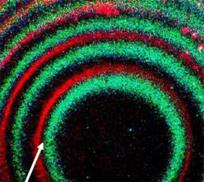The concept of a “trapped rainbow”, the ability to slow down and stop light of different wavelengths at different spatial locations, has attracted considerable recent attention. Unfortunately, due to the necessity of complicated nanofabrication and the difficulty of producing broadband metamaterials, the trapped rainbow schemes had previously remained in the theoretical domain only.
Vera Smolyaninova (Towson University) I. I. Smolyaninov (BAE Systems), A. V. Kildishev, and V. M. Shalaev (Purdue University) demonstrated an experimental realization of the broadband trapped rainbow effect which spans the 457-633 nm range of the visible spectrum. The observed “trapped rainbow” effect is based on light being stopped in a tapered waveguide (a waveguide with gradually changing dimensions) produced between the gold-coated lens and the flat surface. Light is stopped when the waveguide width is equal to the one half of the light wavelength. Therefore, different components of white light (different colors, which have different wavelength) are stopped in different locations inside the waveguide, which leads to the appearance of a rainbow. Being a distinct case of the slow light phenomenon, the trapped rainbow effect could be applied to optical computing and signal processing, and to providing enhanced light-matter interactions. This work in supported in part by NSF grant DMR-0348939. Applied Physics Letters 96, 211121 (2010)
This work has received extensive press coverage (about 700 000 of internet links in science and general news media around the world) including articles in New Scientist http://www.newscientist.com/article/dn18205-rainbow-trapped-for-the-first-time.html , Francis (th)E mule Science’s News, Sciencestage, Tech News Daily. It has been selected for the June 14, 2010 issue of Virtual Journal of Nanoscale Science & Technology. It is listed as one of the top 10 physics stories of 2009 published in New Scientist http://www.newscientist.com/gallery/popular-physics-2009/5 .

